Table of Contents
- Introduction
- Editor’s Choice
- Champagne Market Overview
- Leading Champagne and Wine Brands
- Top Champagne Consuming Nations
- Per Capita Expenditure on Champagne in Various Nations
- Top Ten Champagne-Importing Nations
- Top Ten Champagne Exporting Nations
- Demographics of Champagne Consumers
- Consumer Attitudes Towards Champagne
- Regulations for Champagne in Various Nations
Introduction
According to Champagne Statistics, Champagne, an emblem of sophistication and refinement, epitomizes sparkling wine crafted exclusively in France’s Champagne region.
Influenced by factors like soil, climate, and grape varieties—Chardonnay, Pinot Noir, and Pinot Meunier—it embodies the region’s unique terroir.
Through the traditional méthode champenoise, Champagne undergoes secondary fermentation in the bottle, creating its iconic bubbles.
Classified by sweetness levels from bone-dry Brut Nature to sweet Doux, it offers diverse styles to suit every palate.
Champagne captivates with its elegance and complexity, whether enjoyed as a non-vintage blend or a prestigious cuvée. Best served chilled in narrow flutes, it pairs beautifully with various dishes.
While its influence spans globally, only wines from the region can legally bear its name. Understanding these basics enriches one’s appreciation of Champagne’s timeless allure.
Editor’s Choice
- In 2023, the global champagne market revenue was valued at USD 7.2 billion.
- In 2023, increases were noted in all categories: Prestige Cuvee (USD 1.90 billion), Blanc de Noirs (USD 1.67 billion), Blanc de Blancs (USD 1.14 billion), Rosé Champagne (USD 0.84 billion), Brut Champagne (USD 0.61 billion), and Demi-Sec (USD 1.44 billion).
- The off-trade channel holds a dominant position, accounting for 75% of the market share.
- Leading the Brand list in 2023 was Moët & Chandon, valued at $1,275 million, reflecting its preeminent status in the industry.
- France led the way with a significant consumption of 138.3 million bottles in 2022, underscoring its cultural affinity.
- Luxembourg led the rankings with the highest per capita expenditure of Champagne at €14.7, indicative of its high standard of living and luxury consumption habits.
- In 2022, the United States led the list of top champagne-importing nations, bringing in 34.1 million bottles valued at approximately 793.5 million EUR, marking it as the highest spender on imports.
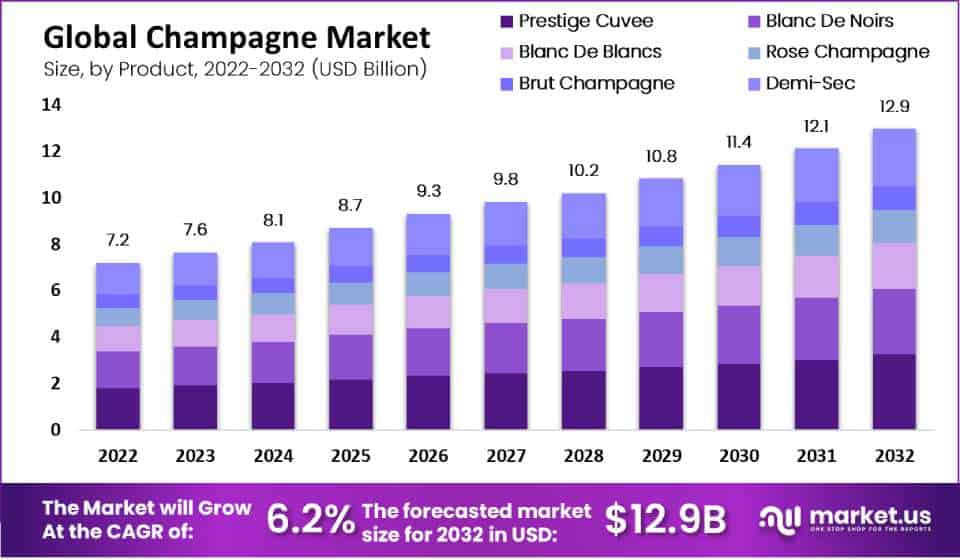
Champagne Market Overview
Market Size
- The global champagne market has demonstrated steady growth in revenue from 2022 to 2032 CAGR of 6.2%.
- In 2022, the market was valued at USD 7.2 billion, and it has incrementally increased to USD 7.6 billion in 2023.
- By the end of the decade, the market is expected to surge to USD 11.4 billion in 2030, with a substantial increase to USD 12.1 billion in 2031, culminating at USD 12.9 billion by 2032.

Size – By Product
- The global champagne market is forecasted to grow significantly from 2022 to 2032 across various product segments.
- In 2022, the total market revenue stood at USD 7.2 billion, with Prestige Cuvee generating USD 1.80 billion, Blanc de Noirs USD 1.58 billion, Blanc de Blancs USD 1.08 billion, Rosé Champagne USD 0.79 billion, Brut Champagne USD 0.58 billion, and Demi-Sec USD 1.37 billion.
- By 2023, these figures rose to USD 7.6 billion overall, with increases noted in all categories: Prestige Cuvee (USD 1.90 billion), Blanc de Noirs (USD 1.67 billion), Blanc de Blancs (USD 1.14 billion), Rosé Champagne (USD 0.84 billion), Brut Champagne (USD 0.61 billion), and Demi-Sec (USD 1.44 billion).

Share – By Distribution Channel
- A significant division between off-trade and on-trade channels characterizes the distribution of the champagne market.
- The off-trade channel holds a dominant position, accounting for 75% of the market share.
- On the other hand, the on-trade channel, which encompasses venues such as restaurants, bars, and clubs where champagne is consumed on the premises, represents 25% of the market.
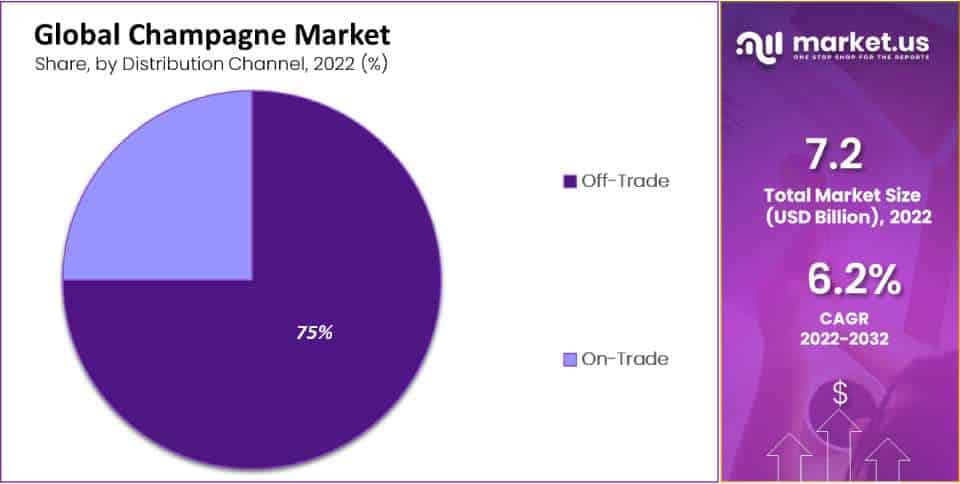
Leading Champagne and Wine Brands
- In 2023, the landscape of the global champagne and wine market was dominated by several key brands, each distinguished by its brand value in millions of U.S. dollars.
- Leading the list was Moët & Chandon, valued at $1,275 million, reflecting its preeminent status in the industry.
- Following closely was Changyu, a prominent brand with a value of $1,053 million, and Chandon, which held a brand value of $1,011 million.
- Veuve Clicquot also featured prominently, with a valuation of $942 million. Dom Perignon, renowned for its luxury offerings, was valued at $750 million.
- Barefoot came next with a value of $742 million, closely followed by Penfold’s at $659 million.
- Beringer, with a brand value of $461 million, Concha y Toro, at $368 million, and Jacob’s Creek, at $313 million, rounded out the list of top global brands based on their market valuation, illustrating the competitive and diverse nature of the wine and champagne industry.
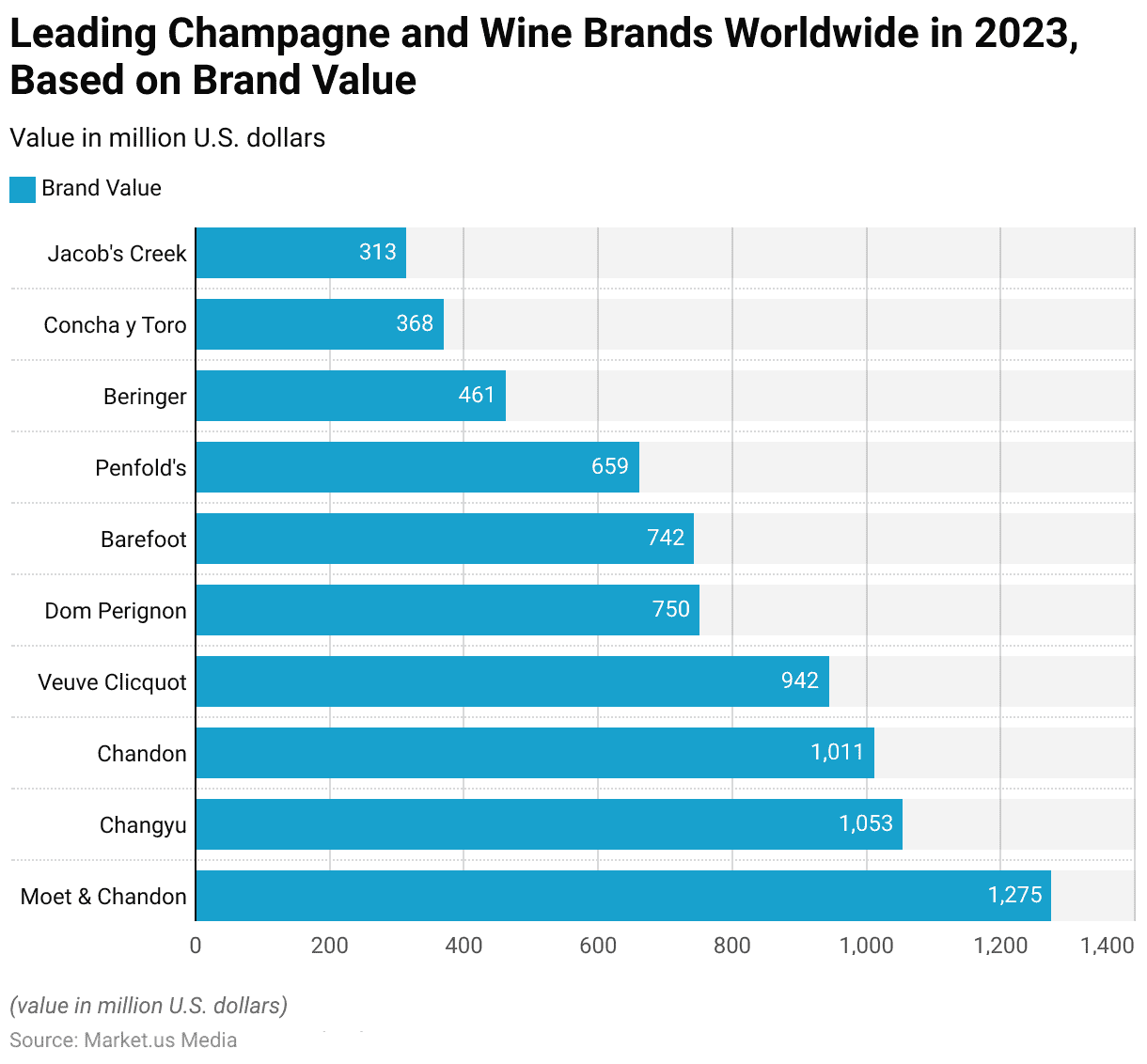
Top Champagne Consuming Nations
- France led the way with a significant consumption of 138.3 million bottles, underscoring its cultural affinity.
- The United States followed as a distant second, consuming 33.7 million bottles, reflecting its large market size and luxury consumption trends.
- The United Kingdom was next, with 28 million bottles consumed, showcasing its longstanding appreciation.
- Japan also showed notable consumption at 16.6 million bottles, followed by Germany with 12.2 million bottles, indicating a strong market presence in these economies.
- Italy and Australia were close competitors in the champagne market, consuming 10.6 million and 10.5 million bottles, respectively. Belgium also demonstrated a solid demand with 10.3 million bottles.
- Switzerland and Spain rounded out the list with 6.4 million and 4.9 million bottles, respectively, illustrating their niche but significant markets for champagne.

Per Capita Expenditure on Champagne in Various Nations
- Luxembourg led the rankings with the highest per capita expenditure at €14.7, indicative of its high standard of living and luxury consumption habits.
- Belgium followed with a substantial expenditure of €12.2 per person, while Switzerland also showed a strong affinity for champagne, with an expenditure of €10.87 per person.
- Hong Kong, representing a major Asian market, had a per capita expenditure of €6.13, showcasing its growing luxury sector.
- Sweden and Denmark in Scandinavia recorded expenditures of €5.32 and €5.1, further highlighting Europe’s dominant position in consumption.
- The United Kingdom, a traditionally strong market for champagne, had a per capita spending of €4.96, closely followed by Australia at €4.89.
- Norway rounded out the list with an expenditure of €3.64 per person, demonstrating the widespread appreciation and varying levels of investment across different economies and cultures.

Top Ten Champagne-Importing Nations
- In 2022, the United States led the list of top champagne-importing nations, bringing in 34.1 million bottles valued at approximately 793.5 million EUR, marking it as the highest spender on champagne imports.
- The United Kingdom followed closely, importing 29.9 million bottles with a total value of 503.6 million EUR.
- Japan was also a significant importer, with 13.8 million bottles imported at a value of 354.5 million EUR.
- Germany and Belgium rounded out the top five, importing 11.1 and 10.3 million bottles valued at 201.9 million EUR and 200.1 million EUR, respectively.
- Australia, Italy, and Switzerland were also notable importers, with volumes of 9.9, 9.2, and 6.1 million bottles and values of 166.9 million EUR, 159.9 million EUR, and 125.6 million EUR, respectively.
- Spain and the Netherlands completed the top ten, importing 4.4 million bottles (94.0 million EUR) and 3.9 million bottles (79.7 million EUR), respectively.

Top Ten Champagne Exporting Nations
- In terms of champagne exports, France stands out as the top exporter, with a substantial shipment volume of 83,098 units, emphasizing its leading role in the global champagne industry.
- China follows as the second-largest exporter, with a significant shipment volume of 52,119 units. India ranks third, contributing 32,094 units to the international champagne market.
- Germany and Vietnam are also prominent exporters, shipping 17,993 and 17,426 units, respectively. Italy closely trails with 17,045 units exported.
- The list continues with Spain, the Netherlands, and Belgium, which exported 12,450, 11,990, and 11,197 units, respectively.
- The United States rounds out the top ten, exporting 9,145 units, showcasing a diverse array of significant players in the global champagne export market.
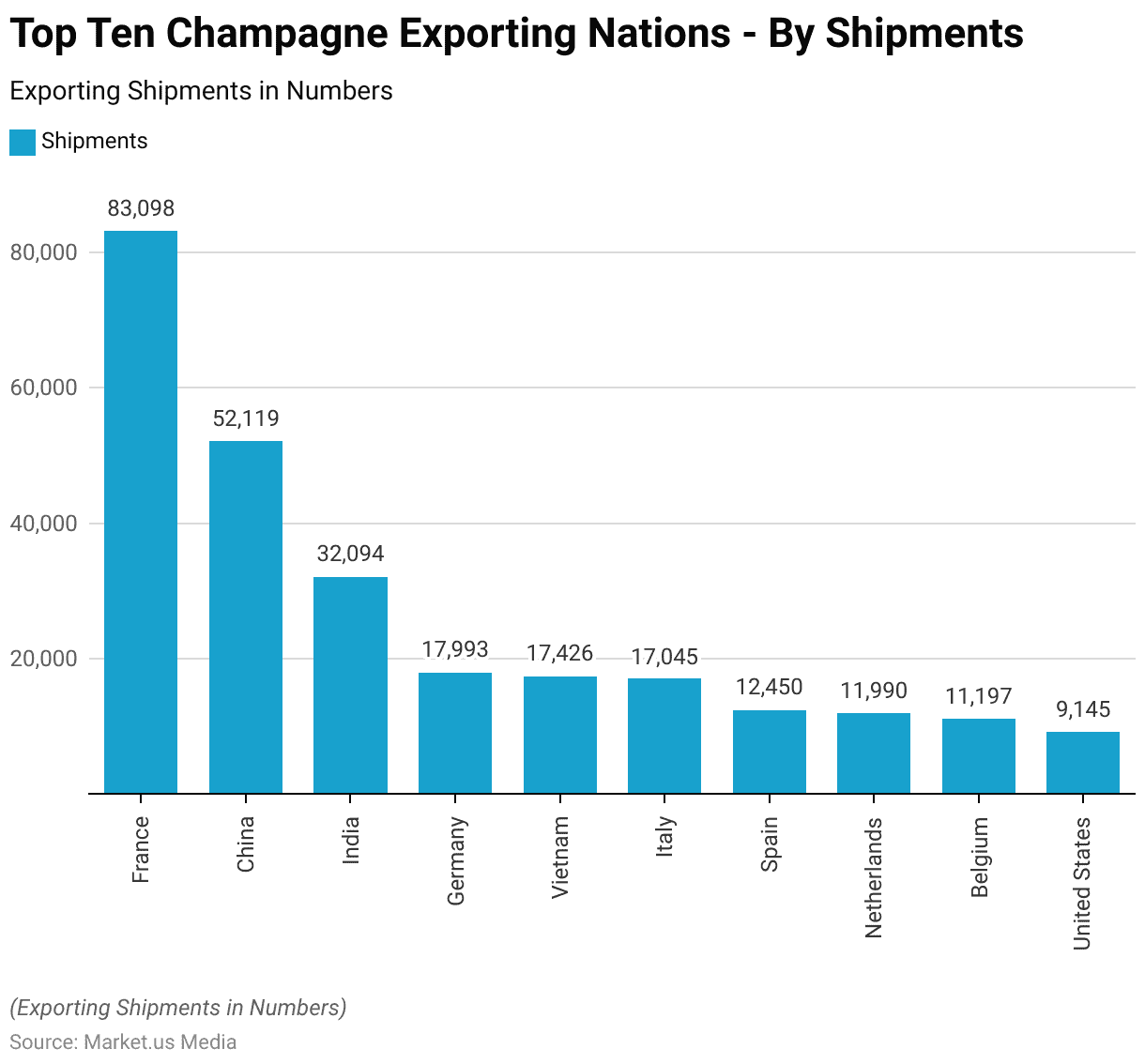
Demographics of Champagne Consumers
By Age and Gender
- The perceived age profile of Champagne, Prosecco, and Cava consumers varies across varieties and genders.
- For Champagne, male drinkers are predominantly in their 40s, with 43% representation, followed by those in their 30s at 22%, and those 50 and older at 15%.
- Only 2% of male drinkers are in their 20s, while 18% do not fall into a specific age profile.
- Female drinkers show a higher percentage in their 30s at 29%, 36% in their 40s, and fewer in the 50 and older group at 12%. About 4% are in their 20s and 20% have no specific age profile.
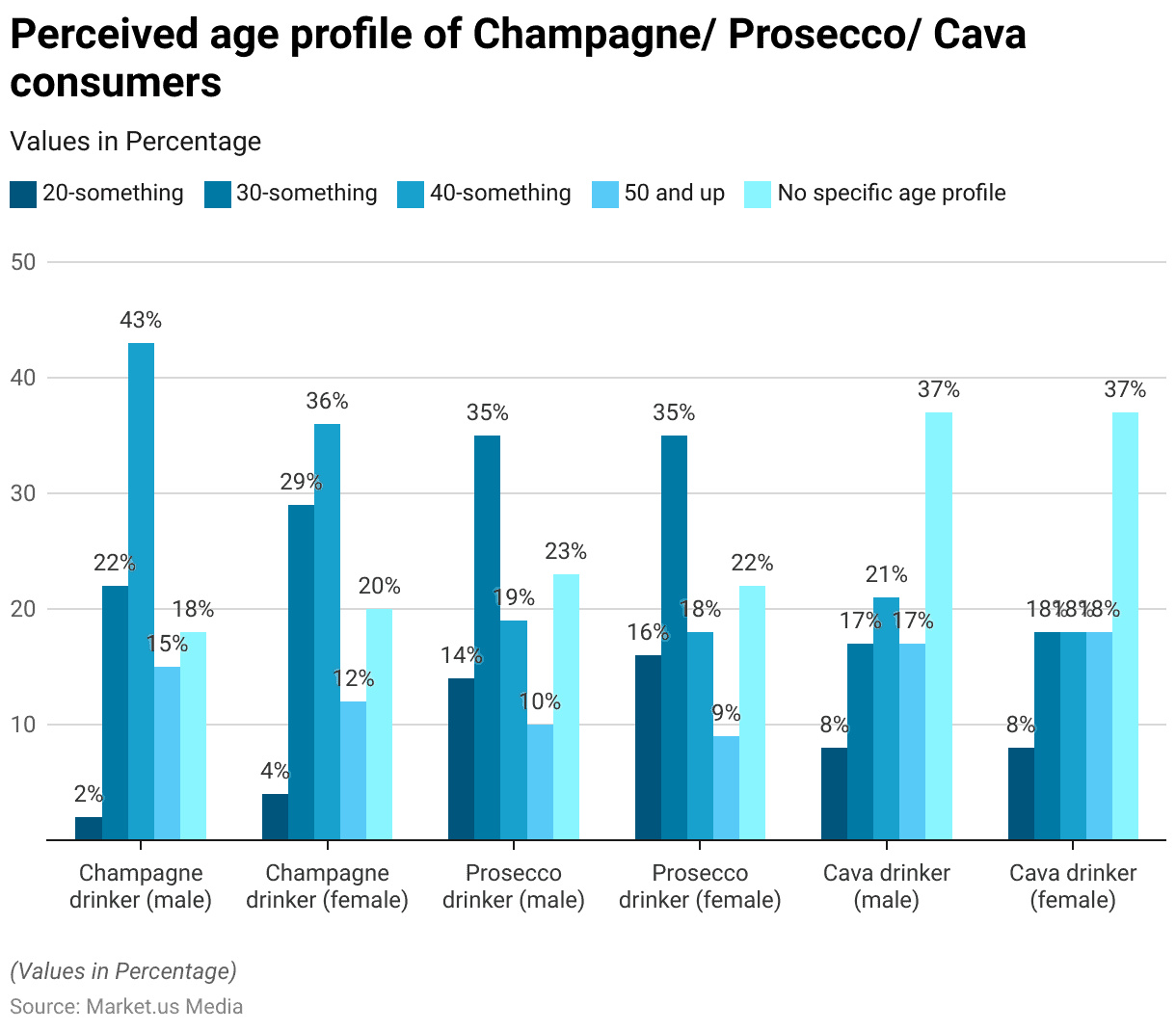
Consumer Attitudes Towards Champagne
- A significant portion of consumers, 56%, either agree (42%) or strongly agree (14%) that Champagne is too expensive.
- Conversely, 60% of respondents would be inclined to buy more if it were cheaper, with 37% agreeing and 23% strongly agreeing with this sentiment.
- Most consumers perceive it as more expensive than Prosecco or Cava, with 72% either agreeing (34%) or strongly agreeing (38%) with this statement.
- However, opinions are mixed regarding the justification of Champagne’s price; 39% believe the price is justified, split between 30% agreeing and 9% strongly agreeing, while 28% disagree or strongly disagree.
- A majority, 58%, are willing to pay more for compared to other sparkling wines such as Prosecco or Cava, with 37% agreeing and 21% strongly agreeing.
- Regarding the availability of affordable, high-quality Champagne, consumer perception shows skepticism. Only 17% believe there is good quality available for less than 10 euros, with 13% agreeing and a mere 4% strongly agreeing.
- Similarly, for Champagne under 15 euros, 44% think it is possible to find good quality, split between 31% agreeing and 13% strongly agreeing.
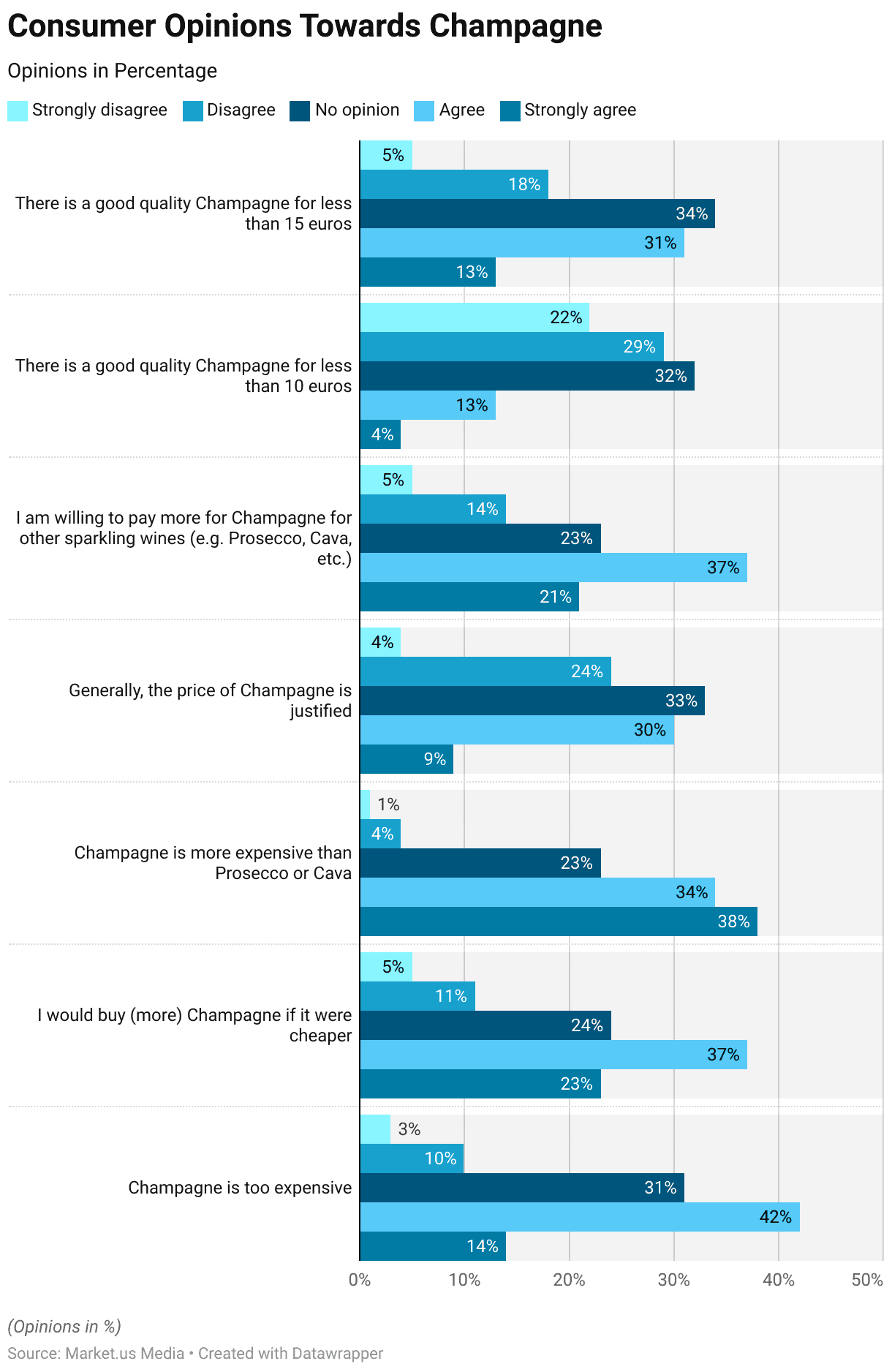
Regulations for Champagne in Various Nations
- In the EU, Champagne is protected under the Protected Designation of Origin (PDO) status. This means that only sparkling wine produced in the Champagne region of France, using specified methods (Méthode Champenoise), can be legally sold.
- The U.S. follows similar protective measures but with certain exceptions. Due to pre-existing agreements, some American producers can still use the term “Champagne” if they used it before 2006.
- Japan adheres to strict import standards that align with EU regulations, recognizing that is only from its French region.
- China has recently tightened its regulations around the labeling, allowing only products imported from France’s region to be labeled as such.
- Australia has agreed to phase out the use of the term “Champagne” for local products as part of its Free Trade Agreement (FTA) with the EU.
Discuss your needs with our analyst
Please share your requirements with more details so our analyst can check if they can solve your problem(s)



